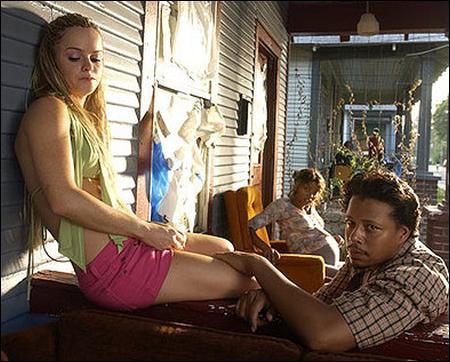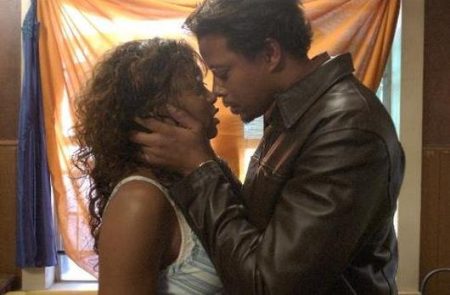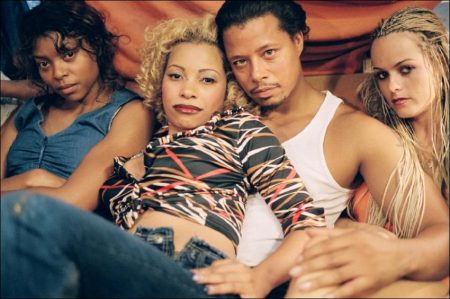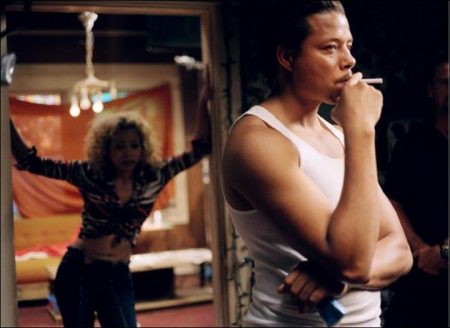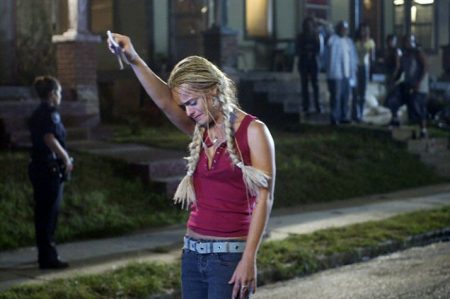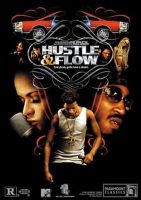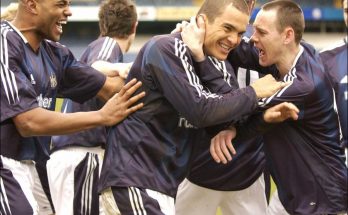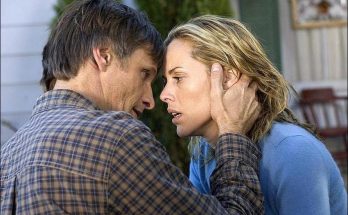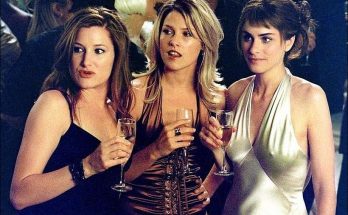Taglines: Everybody gotta have a dream.
“Hustle & Flow” is the redemptive story of a streetwise Memphis hustler trying to find his voice and realize his long-buried dreams. Though DJay (Terrence Howard) has always had a way with words, that gift has long been misused; this philosopher-hustler lives a dead-end life at the fringes of society. Anything more feels out of reach. Still, DJay wonders what happened to big dreams he had for his life.
A chance encounter with an old friend, Key (Anthony Anderson), a sound engineer who has always wanted to make it in the music business, spurs DJay: if he’s ever going to make his mark, it has to happen now. He begins to write down his freestyle raps – his flow – and the two team up with Shelby (D.J. Qualls), a church musician with a beat machine, to lay down bass-thumping crunk tracks.
DJay’s metamorphosis affects his entire house, as the women in his life – Shug (Taraji P. Henson) and Nola (Taryn Manning) – find ways to contribute to the creative process. With the impending visit to Memphis of hometown platinum-selling rapper Skinny Black (Ludacris), DJay has to make one last hustle if he’s ever going to flow.
“This is a Memphis story – a movie about making music by any means necessary,” says Craig Brewer, writer-director of the new film “Hustle & Flow.” “Music has been our common love and language. It’s our chance to take our pain, our struggle, our tools, and put it into something that has a beat, raw and unfiltered.”
“Hustle & Flow” is the story of DJay, a hustler who finally figures out a way to realize his dreams. An ultimately universal story set in the world of Memphis hip-hop music and inspired by the rhythms of that city, “Hustle & Flow” features new music by innovative artists that bust genre barriers. Driven by a tour-de-force performance by Terrence Howard, “Hustle & Flow” received the Audience Award and Cinematography Award at the 2005 Sundance Film Festival.
Producer John Singleton, who had previously directed the hit films “Boyz N the Hood,” “Shaft,” and the upcoming “Four Brothers,” agrees that the film’s universal themes cross boundary lines. “Hip-hop has now pervaded popular culture; it’s taken up the same cultural space that rock `n roll once did and Craig knows this world – particularly Memphis hip-hop – inside-out,” notes the producer.
“I felt that `Hustle & Flow’ is a Memphis story – much like the story of Elvis Presley or Isaac Hayes,” adds Brewer. “Those guys didn’t have much, but the fact that they didn’t have much created the very people that they were and made them unique in their craft; that fact ultimately propelled them into greatness.”
Brewer says the idea for the movie came from life. “My father had died, very unexpectedly; I was beginning to have thoughts of my own mortality,” he says. “I lost him to a sudden heart attack – he never smoked and never drank, but a blood clot ended his life at age 49. When you are the only son and your father dies at 49, you can’t help but think you’re on borrowed time after age 50. Being that I was 27, I couldn’t help but feel that I was past the halfway point.
“At the same time, I was location scouting in Memphis for another movie and this hustler rolled up on me. He was trying to sell me his woman, and his mumble, his hustle, his spin, was unrelenting – he even tried to sell me his car. He just would not let me go. So I just put the two together – I thought, `Man, if that guy had the same mid-life crisis that I had, and suddenly he started thinking about making something creative, what kind of story would that be?’ It seemed to me that his creative outlet would be music – in Memphis, that means hip-hop, crunk – and his hustle would translate into his flow.”
Out of that encounter, Brewer invented DJay, a hustler trying to make good by finding his voice. Terrence Howard plays the role of a man desperately trying to change his life. “I had to let go of 80% of what I know and concentrate on what makes DJay who he is,” says Howard. “For someone like DJay, it’s about survival. Craig once told me, `DJay is not as smart as you are. If you were in this situation, you would handle it a lot differently. DJay only has what he has.’”
To learn the life of a street hustler in Memphis, Howard spent time with Juicy J of Three 6 Mafia, a local Memphis crunk group. “J taught me that someone in DJay’s position can’t allow emotion or sympathy to compromise his situation,” says Howard. “I learned that to become someone like DJay, I’d have to let go of a piece of my conscience and take hold of a bigger piece of trying to survive.”
Still, it was the everyman quality of the character that lured Howard to the role. “`Hustle & Flow’ is about the human experience of wanting to better yourself, wanting more,” says Terrence Howard, who plays DJay. “We can all relate to it. Even if your life is completely different from these characters’, there are elements to what they’re going through that we can all relate to. You feel for DJay and see that he’s struggling and trying to better himself. That’s a human and very universal story, because we’ve all been there, no matter what your environment or passion is – when we stop wanting more, the flame dies.”
If the character of DJay is one that everyone can relate to, so is the experience of Craig Brewer, the film’s writer-director. After struggling to make the film for three years, Brewer’s tenacity saw it through. “I’m exactly like DJay,” agrees Brewer. “There is a lot of hustling to making guerrilla, low-budget, independent films, and even when I came to Hollywood, I realized I had to do the same amount of talking and hustling. I felt like I was always hustling in order to flow.”
Though race doesn’t play a factor in “Hustle & Flow,” Brewer is aware that some people will wonder why he, a white man, is telling this story. “I knew people were going to ask about this,” Brewer continues, “but this story is not about black and white; I’m writing about a world I know well. In creating the character of DJay, I tried to work against the stereotype, to make him a complex person. I didn’t want to glorify DJay’s lifestyle – I wanted the audience to see the humanity of this person without ignoring his flaws. What intrigues me about DJay is how his raw emotional and economic level affects his actions in these situations.”
Having written the screenplay in 2000, Brewer found a fan in Stephanie Allain, who came on board the project from the very beginning. “Stephanie was on the movie for three years,” says Brewer. “I’d try to quit, but she wouldn’t let me. She flew me to L.A. on her own dime; sometimes, she paid my rent.”
“When I read the script, I was transported. I felt like I was in the hands of a master storyteller,” says producer Stephanie Allain. “It was exciting. Craig isn’t afraid to put complex characters in desperate situations and then reveal their hearts.”
Allain shopped the script around Hollywood, Allain sold her house in order to continue to push ahead on the film until finally, she was ready to put her money where her mouth was. Remembers Craig, “Stephanie said, `When you made your first feature, `The Poor & Hungry,’ you made a really good movie for 20 grand; let’s see what $400,000 can do.’”
More than a decade ago, Allain had been the creative executive who brought John Singleton’s “Boyz N the Hood” to Columbia Pictures. Allain now wondered if Singleton, who had just helmed the international hit “2 Fast 2 Furious,” would be interested in financing the movie with her.
After reading the screenplay, Singleton flipped out. “It was different from anything I’d read,” he says. “I loved how audacious it is. Then I saw Craig’s first film, and I thought, `Wow, this guy can direct.’”
Singleton was willing to get behind the project, but not in the way Allain and Brewer initially intended. “He said, `Man, it’s gotta be a bigger budget. Let’s do it right,’” says Brewer, noting that Singleton believed that with a filmmaker of his experience attached, funding would come easier.
But it didn’t… and when it didn’t after a year of searching, Singleton then made the brave choice to put up the complete financing for the film himself. “I thought, `Okay – I’ll greenlight the movie,” says Singleton.
“John understood that I am a regional filmmaker,” says Brewer. “I’m trying to do in Memphis the same thing that he’s doing in South Central – and he believed that I was the guy to do it. We just bonded. We like to explore the same kinds of characters, the same types of complexities, and the same issues involving men and women, and they’re not always pretty. I think we both live in tangled places and that seeps into the character of everyday life.”
Singleton’s belief in the film paid off when it received the Audience Award at the 2005 Sundance Film Festival. “This movie became about all of us trying to do something different,” says Allain. “It was about John Singleton wanting to work outside the system, and about Terrence stepping up to the plate as a lead actor. Anthony Anderson is primarily known as a comic actor; here, he gets to do a dramatic turn. Everyone who made `Hustle & Flow’ became like a family, and Craig was DJay, leading the family, trying to help us live our dream.”
“Everybody involved in this movie needed it,” says music supervisor Paul Stewart. “Craig needed the movie. Al Kapone – a Memphis rapper who wrote many of DJay’s raps – he needed it. Everybody needed it – and they brought it.”
About the Characters
At the center of “Hustle & Flow” is DJay, a hustler trying to make good. Having reached the age his father was when he died, DJay is at a crossroads.
“He doesn’t want to live the life of a hustler anymore,” says Terrence Howard, who plays the aspiring rapper. “DJay is like a shepherd with a flock. These girls are his family; he’s the father figure, and when they’re in a dark place, it’s up to him to find the way out.
“`Hustle & Flow’ doesn’t glorify DJay,” adds Howard, noting that the characters live a hard life, hustle-to-hustle. More to the point, the film shows a side of the life that hasn’t often been seen on-screen. “It breaks DJay’s heart to send these girls out to do these things. He tries to think of a better life, to keep his sanity.” When DJay is no longer able to forget the role he plays, he sets into motion a plan that affects them all.
“This kind of character is so much more interesting than the covered-in-jewels, holding-a-gold-goblet type of pimp that I’ve usually seen in movies, because this is a kind of classic Memphis hustler,” says Brewer. “Talking is a lot of what this guy is. And it’s that gift of gab that ultimately leads to DJay’s flow. He’s always been pretty good at connecting the dots.”
From the very beginning, Brewer was convinced that the role should be played by Howard and not by a well-known rapper. “Terrence Howard is a man who understands DJay to the core of his being – he’s always been a fantastic actor who has never really been given a shot to lead a movie himself,” says Brewer. “When you have the right person to play the part, you feel like you have a shot at making something that’ll stand the test of time, because you know that you have an actor that’s also thinking of that same thing. That was Terrence.”
As much as the filmmakers were convinced that Howard was the man for the role, Howard had reservations. “I was scared,” he admits. “This was someone I felt I knew. There are certain things about your life that you suppress, and when they’re brought into the light, it’s not an easy thing to accept. But Craig was so loyal to me – standing up for me when others wanted a rap star to play the part – that I put that aside and came to the table. I had to bring DJay to life.”
According to Howard, some of his inspiration to play the part came from his mother, who raised four children while, for a time, auditioning for parts. “She’d try and take off time for auditions, but she couldn’t. She would come home disappointed; she’d pour all of that into me. I think she was like DJay, holding on to her dreams, but wondering how she was going to fulfill them.”
To play the role, Howard had to immerse himself in the world of crunk music – a genre of rap specific to the south and Memphis, Tennessee, where the film takes place. “Terrence is a singer,” says Allain, “but more of a balladeer. He had to shake that off and take on a Memphis crunk vibe.”
John Singleton adds, “I knew that Terrence could play the hustler part of DJay, but I needed to be sure that he could also rap before making such a major investment. Terrence and I flew to Memphis and I introduced him to Juicy J and Paul from Three 6 Mafia. Terrence recorded `Pop It for Some Paper,’ which completely broke the ice. That moment was absolutely magic, because then I knew that Terrence Howard could really pull off the role of DJay.”
“Watching Terrence become DJay was really exciting,” Allain continues. “The guys in Memphis – Juicy J, Al Kapone – totally embraced him. Terrence was able to pick up the Memphis style, especially the flow – the cadence of lyric.”
“He started to rap first, getting the rhythm,” says Brewer, “and that ultimately led to his language, the rhythm, and the character.”
DJay isn’t sure about his next step in life until he reconnects with Key, a middle-class recording engineer who makes a good living but also had dreams of something greater.
“Key’s a dreamer,” says Anderson. “He has a line where he says, `I sold my wife this dream about having my own studio, being in the music industry, making it happen. And now I feel like I’m just paying the rent.’ For him, there’s nothing worse than a dream deferred.”
“It’s one thing to show a character like DJay, with all his flaws and all his street swagger, but I needed to have a rock,” says Brewer. “I wanted some guy representing the normal guy out on date night watching this movie. He represents the thoughts of the audience: `Hey, I’ve got a nice house, I’ve got a nice wife, I go to church, I go to work every day, I’m not about smoking weed or getting drunk all the time, but these characters – if I meet them, if they come into my life and are my friends, I’m not going to be turning away from them.’ I feel like there’s a lot of guys like that.”
“My conversations with Craig were about that – being the regular guy in the audience watching the movie,” says Anderson. “Just like DJay is going through his crisis, Key’s going through a similar thing. They find what they need in each other to get through it.”
“I found it very interesting that we had Anthony Anderson, who’s a classic showstealer, when we needed somebody who would not steal the show from DJay,” Brewer continues. “I told him, `Just remember, he’s not a performer. When things are funny, it’s going to be because of the situation and not because this character is trying to be funny.’ He completely understood that, and even more to the point, was thankful to be doing something like that.”
“I love what I’ve had the chance to do so far in my career, but to get something as meaty as this – different from what people generally know me for – I had to jump at it,” Anderson elaborates.
Driving the action of the film is the impending visit of Skinny Black, a rapper from Memphis who has gone Hollywood. DJay professes to have known Skinny “back in the day” and wants to press his demo tape on the famed rapper. Multiplatinum-selling rapper Chris Ludacris Bridges plays the part.
“Chris is a deep and rich actor,” says Brewer. “It is hard to improvise with Terrence the way he was doing at times. I had it all written out, but Terrence suddenly started going off in a direction and Chris didn’t bat an eye. Some people freeze up and freak out about that, but not him – he was just rolling with it.”
“When I put my toe in the movie business, I decided I didn’t want to play rappers or singers, but this part was so good I had to make an exception,” says Bridges.
“John and I made it clear that we wanted him to be as far from himself as possible, mainly, be a jerk,” says Brewer. “Ludacris still lives in Atlanta. He still tours throughout the south. He is everything that Skinny Black is not. Skinny Black is a guy that quickly left; he got paid and he’s living the Hollywood life. That’s not Chris.”
D.J. Qualls plays Shelby, an aspiring musician and master of the beat machine. “Qualls brings authenticity,” says Brewer. “He’s from Nashville and I always wanted to see him to play a character that wasn’t just a joke. He’s a very interesting guy – a thoughtful, mature individual. I think audiences feel very comfortable with him; they think, `I know this guy, he’s kind of funny, I’ve been around with him a bit.’”
“I was attracted to this project by the truth in the way the South is portrayed,” says Qualls. “It just felt real. The stereotype about the South is that it’s racist, but the fact is that it’s so poor there – poverty is the great leveler – that it’s probably one of the least racist places I’ve ever been. You don’t have time to hate people whne you’re trying to feed your family.”
Qualls was also intrigued by the universal quality of the screenplay. “I live in L.A. now, and this is a town full of dreamers. Everybody wants to be something bigger than they are,” he notes. “I felt it myself, when I was sitting in Nashville, wanting to be an actor so bad and not knowing how to make it happen. That’s what this movie is about.”
Nola (Taryn Manning) is one of DJay’s ladies. Young, impressionable, Nola has nothing in her life except DJay. “Nola has a certain ignorance about her that comes from being a runaway from Arkansas or Chattanooga or Mississippi. There’s a certain naivete to the fact that she’s being exploited. Suddenly, everybody in this house except for Nola has something to do, because she doesn’t have anything that she knows that she’s good at – but only because nobody’s ever demanded more of her.”
Manning describes the relationship between Nola and DJay as a complex one. “There’s no sex between them; it’s very much a brotherly-sisterly relationship. At the same time, she really looks up too him, hangs on his every word, believes everything he says. It goes too far; DJay definitely takes advantage of Nola. But she finally does come out of her shell; that’s not going to happen to her anymore.”
Manning says that Brewer had her in mind for the part from the very beginning – even though the director didn’t know it. “He had put together a `look book’ as a way of presenting the film to possible financiers,” Manning says, “and he cut an old picture of me out of a magazine to represent Nola. When he was getting ready to audition actresses, he said, `Well, can I audition her?’”
Also in the house is Shug (Taraji P. Henson), one of DJay’s women, who happens to be pregnant. “Her pregnancy brings the same kind of hopes and fears and anxieties that DJay has,” says Brewer. “She’s the only one that DJay can really trust with his heart, because she’s going through a similar thing.”
Paula Jai Parker takes the role of Lexus, who doesn’t believe in what DJay is trying to accomplish. “I told Paula, you need to be uncompromising,” says Brewer. “You need to be like a Memphis thunderstorm: you need to come in, you need to cause some chaos, and then just leave – and not give a damn.”
Memphis legend Isaac Hayes makes an appearance as Arnel, the owner of the bar where the Fourth of July confrontation with Skinny Black goes down. “We had to have him,” says Brewer. “I said, `Imagine Truck Turner turning in his guns and opening up a bar and retiring. That’s Arnel.’”
About the Music
“I’ve moved around a lot and music was always the connecting element to my home in Memphis,” Brewer says. “Whenever we would come back home, music was always a very important part. I was raised on Otis Redding and Sam & Dave, on Muddy Waters and Howlin’ Wolf and Buddy Guy and Elvis Presley and Jerry Lee Lewis. I found that when I started making movies and wanted to have some rap in them, the Memphis rappers were really keeping up the tradition of Sam Phillips, recording at Sun Studios. They’re getting it made by any means and sometimes the means will ultimately inspire the culture.”
Though Memphis had been the birthplace of rock and roll, the region had more recently lost some of its influence. Memphis crunk rapper Al Kapone, who provides two of DJay’s tracks with “Hustle & Flow (It Ain’t Over)” and “Whoop That Trick,” notes that the crunk sound comes out of the roots of Memphis music. “We’ve got such a deep history of music out of this city, from Stax to Elvis to rock-and-roll to the blues, but by the time my generation started growing up, it had crumbled,” says Kapone. “We always knew there was something here, but we were never able to carry the torch. We always had this energy wanting to bust out – we wanted to be heard and be recognized.”
“Crunk is a subdivision of southern hip-hop. It’s a very regional music that came out of certain areas of the south,” says music supervisor Paul Stewart, who had previously collaborated with producer John Singleton on the filmmaker’s “Poetic Justice” and “2 Fast 2 Furious.” “It’s a very high-energy dance music, somewhat aggressive and in-your-face, and representative of the life, the street life. Lyrically, it speaks to the southern culture and life. Before it emerged from those areas, they were listening to records from other places. It’s a real emergence of their culture. People in the south like to party; the west coast and east coast have a very different kind of vibe. In the South, music has a unique flavor, coming from a unique musical history there.”
“Ludacris said, `It came from crank, from cranking up your car,’” notes Brewer. “That’s a good example – it’s already going, it’s driving, it’s revving, it’s loud and repetitive. You’re chanting throughout the whole thing.”
For Stewart, the chance to showcase crunk – a part of hip-hop that is often ignored by mainstream critics – was irresistible. “What was really exciting about the film was we were able to put this music – sometimes viewed as the lowest type of music – in a context with Al Green, Willie Hutch, and a score of players from Stax Records,” says Stewart. “In addition, our composer, Scott Bomar, brought in the dream team of classic Stax musicians to do the score. Some of these guys also played on the Isaac Hayes’s `Shaft’ soundtrack and albums like `Hot Buttered Soul.’”
Since working on “Hustle & Flow,” Stewart says he’s been approached by people who aren’t usually a fan of the genre but found themselves humming the movie’s signature tunes on the way out of the theater. “So many people have come to me and said, `Oh, that’s not really the kind of music I like, but, wow. I really dug it,’” he notes.
Brewer says he’s been a fan of the genre for a long time. “I was listening to crunk before I knew it was called crunk,” he notes. “I was listening to Ludacris, I was listening to Three 6 Mafia, I was listening to Al Kapone, I was listening to Eightball & MJG, Pastor Troy, Juvenile – these are all guys that helped contribute to that sound. Only recently has crunk become a word that people know what it is.”
Stewart notes that crunk could only have come from the south. “It’s poor out there,” he says. Because of that, he says, it seems that people are desperate to find an outlet. “When they’re hanging out, they have fun. They let go. It reminded me of punk rock – it’s almost to the level of throwing elbows. People get real hyped when they party.
“Hip-Hop started on the east coast – that’s where the industry was – but they picked it up in the South pretty quickly,” Stewart continues. “Because the industry wasn’t there, it was ignored for a long time, but that let it develop its own sound.
“From a business standpoint, there’s a whole industry in the south – they don’t need the rest of the country,” adds Stewart. “Once the party element of crunk spread, it became the pop music of hip-hop. They can play that in New York, L.A., the south – wherever you go, you’re going to hear that kind of music now.”
Ultimately, Stewart says, crunk is popular because of one thing. “If you can’t dance to it, you can’t dance,” he laughs. “It’s a universal thing. It’s permeated.”
Three new songs – DJay’s songs – are the highlights of the soundtrack. The filmmakers turned to local Memphis artists Three 6 Mafia and Al Kapone to write these songs. Kapone turned out “Whoop That Trick” and “Hustle & Flow (It Ain’t Over),” while Three 6 supplied DJay’s “It’s Hard Out Here for a Pimp.”
Kapone, a local Memphis crunk rapper, became involved with the film through one fortuitous phone call. Having worked with Brewer on his previous feature, “The Poor & Hungry,” Kapone placed a call to Brewer to see how the filmmaker was doing. At the same time, Brewer was preparing the music for “Hustle & Flow,” and at Singleton’s suggestion, had begun to work with Three 6 Mafia and was expecting a call from the group’s DJ Paul.
“Halfway through the conversation, he realized he wasn’t talking to DJ Paul – he was talking to me!” laughs Kapone. “That’s when he started to tell me what was going on, about the movie and working with Singleton. He said that John pretty much had made up his mind to work with Three 6 Mafia, because they had already done previously work on `Baby Boy.’”
Because Brewer had been a fan of Kapone’s music and had successfully worked with the rapper in the past, Brewer promised to get him a shot with Singleton, but there was a catch. “Al Kapone had one shot to get that song right,” says Brewer. “Kapone really had to dive into the plot and the character. I gave him Terrence Howard’s home phone number, and he talked to Terrence for a long time. It was one of those situations that something out of the movie happened right in front of us. He did it in one night: wrote all the lyrics, put down the beat, everything.”
“I just put the raw emotion into the lyrics,” says Kapone. “I was trying to make the character seem like someone for real; if you didn’t know it was a movie and you listen to the song, you would think it was someone out here telling their story.”
By the next day, Kapone had recorded everything except the singing hook. “That’s when we came up with `keep hustlin’, keep flowin’,’ to go along with the title of the movie,” he says. “When all that was done, Singleton came to town the next day, and the first thing I’m thinking is, `Damn, dude, this is the “Boyz N the Hood” John Singleton! I’m auditioning for Singleton!’ It was a trip.
“We played the song for him,” Kapone says, “and he was listening and halfway through the first verse, he just starts smiling, like, `Damn, this is hot!’ Before the song was over, he was up dancing and enjoying it. That’s when I knew, `OK, I think he really likes the song.’ He said, `You really hit it on the head. The whole point, the whole meaning, all the feeling and energy, was right on point.’”
Kapone had passed the audition. “Singleton was like, `Man, you got anything else?’” says Brewer. “Anything else” turned out to be “Whoop That Trick,” a song that Kapone had been planning to put out himself, but turned out to be perfectly suited to be DJay’s first recording.
“After seeing Skinny Black has already made it, DJay’s thinking, `Man, I could do that,’” says Kapone. “At that point, he’s just letting out raw emotion. The emotion ain’t clean, it ain’t apologetic; it’s straight to the point: `WHOOP THAT TRICK! This is how I feel and you’re gonna recognize me!’ All that plays a part of letting off that first, raw piece of energy.”
The songs were initially recorded by the respective performers. Following that, Howard recorded the tracks in-studio and lip-synched to his own performance on-camera. It was Stewart’s responsibility to ensure that Howard could convincingly play the role of a Memphis rapper. “Terrence is a talented, musical person; he’s a singer and a guitarist,” says Stewart. “He was an obvious choice because of his acting ability, but there was a concern if he could pull off the rapping. My main job with Terrence was to assess if he could do it, get him ready for it.”
Before long, everyone was satisfied that Howard had the chops. “It was in him or he wouldn’t have been able to do it,” he says. “I made him a lot of CDs of music. But then, we had him hanging out with the Three 6 guys at their studio, hanging out with Al Kapone at his studio, and he caught onto the dialect.”
“A big part of it was coming down to Memphis and learning how these people talk,” Howard says. Through the filmmakers, he met local crunk artist Juicy J, part of the Three 6 Mafia camp. “Juicy J took me under his wing,” says Howard. “He told me what cats in Memphis do all the time, taught me the game of conversation, how to deal with women, everything.”
Juicy J and Al Kapone also appear in the film as Skinny Black’s two right-hand men.
Filming in Memphis
“Music and sweat has been pounded into the very bricks of this place,” says Brewer of his hometown, Memphis, Tennessee. “It’s always been a place of misplaced hope. Everybody in the delta and the country came to Memphis to see if they could make something, but they would get stuck in it. There’s something about Memphis that’s got a whole lot of sin and a whole lot of salvation and they are equally tantalizing.
“I have a love for even the things that I hate about Memphis,” Brewer continues. “`Hustle & Flow’ had to be filmed in Memphis. This town has got character to it. It’s still relatively untouched by progress.”
One of Brewer’s favorite locations in the film is DJay’s neighborhood. “I always loved that stretch of houses out on St. Paul Ave.,” he says. “To me, it has a very iconic look; southern houses are like that, uniform and all very close to each other. Shotgun houses, they call them.
“When we were filming in that neighborhood, everybody always said, `Oh, you’re in a bad part of town, be careful.’ And we didn’t get any of that,” says Brewer. “We got nothing but love. We had hundreds of people pulling up their lawn chairs and watching us film. When we all said `Be quiet,’ they all turned off their window units. I mean, that means your house gets hot, but they all did it. I get emotional thinking about how this stretch of neighborhood was helping us make a movie.”
Straight outta Memphis is DJay’s “hooptie”: his beat-up car. “I can’t get enough of them,” Brewer says. “When I roll down South 3rd St., I’ll see a car like an old Chevy Caprice or a Cadillac or a Pontiac, with primer spots and different panels, and I can’t take my eye off `em – there’s something that’s so beautiful to me about them. The chrome wheels always draw your eye – they give the car some sort of uniformity. The uglier the top is, the shinier the wheels are, and I just think, Man, that’s beautiful.’ There’s just something about it that feels like DJay.”
A film by a Memphis native featuring a sound exclusive to Memphis and a character that could only have come from its streets had to be shot there. “I felt like I was at home,” says Brewer. “I made `Hustle & Flow’ the same way I made my first movie and my short films. I picked all the locations; I knew all the extras we were using; when we filmed at the strip club, I knew the strippers we’d cast; when needed a bunch of cars, I knew where to go to get them. I was just making another movie in Memphis, it was just with this big crew and A-list actors coming out to do it. It had to be filmed there.”
Hustle and Flow (2005)
Directed by: Craig Brewer
Starring: Terrence Dashon Howard, DJ Qualls, Ludacris, Taryn Manning, Anthony Anderson, Taraji P. Henson, Elise Neal, Paula Jai Parker, Jordan Houston, Ludacris
Screenplay by: Craig Brewer
Production Design by: Keith Brian Burns
Cinematography by: Amy Vincent
Film Editing by: Billy Fox
Costume Design by: Paul A. Simmons Jr.
Set Decoration by: Joni Wheeler
Art Direction by: Alexa Marino
Music by: Scott Bomar
MPAA Rating: R for sex and drug content, pervasive language and some violence.
Distributed by: Paramount Classics
Release Date: July 22, 2005
Visits: 46
